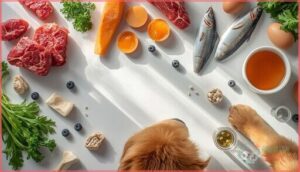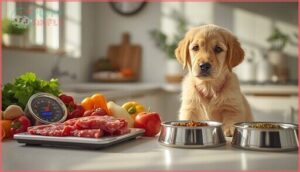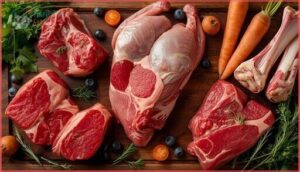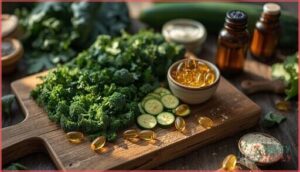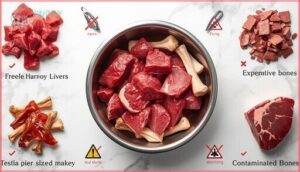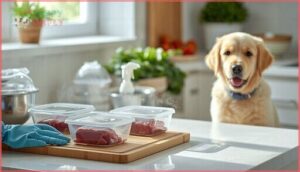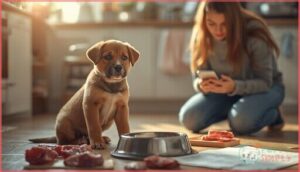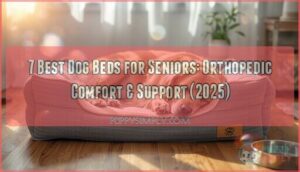This site is supported by our readers. We may earn a commission, at no cost to you, if you purchase through links.
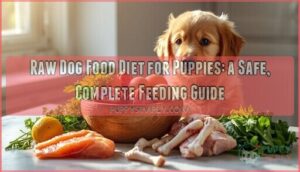
Your puppy’s digestive system is remarkably similar to a wolf’s, equipped to break down raw meat with stunning efficiency—protein digestibility can reach nearly 99%. Yet many new puppy owners feel overwhelmed when considering a raw dog food diet for puppies, unsure whether they can safely provide what their growing companion needs.
The concerns are valid: balancing calcium and phosphorus for developing bones, preventing bacterial contamination, and ensuring your pup gets every essential nutrient requires more than just tossing raw chicken in a bowl.
With proper knowledge about ingredient selection, safe handling practices, and feeding guidelines adapted to your puppy’s age and breed, you can confidently approach this method of nutrition while supporting healthy growth from those first wobbly weeks through boundless adolescence.
Table Of Contents
- Key Takeaways
- What is a Raw Dog Food Diet for Puppies?
- Benefits of Raw Feeding for Puppies
- Essential Nutrients for Puppy Development
- How to Safely Transition Puppies to Raw Food
- Feeding Guidelines and Schedules for Puppies
- Choosing and Preparing Raw Food Ingredients
- Safe Handling and Storage of Raw Puppy Food
- Addressing Health Risks and Safety Concerns
- Common Challenges in Raw Feeding Puppies
- When to Consult a Veterinarian About Raw Diets
- Frequently Asked Questions (FAQs)
- Is raw dog food good for puppies?
- Can puppies be on a raw diet?
- What raw food should I start my puppy on?
- Do vets recommend raw food for puppies?
- Can puppies with food allergies benefit from raw diets?
- How do I introduce raw bones to my puppys diet?
- What are the signs of nutritional deficiencies in puppies?
- Can I mix raw food with cooked food for puppies?
- How often should I consult with my vet about raw feeding?
- Can puppies eat raw fish safely?
- Conclusion
Key Takeaways
- Raw diets can offer high protein digestibility (up to 99%) and improved coat health for puppies, but studies show 60–80% of home-prepared raw meals fail to meet AAFCO puppy nutrition standards, particularly for calcium-phosphorus balance critical to skeletal development.
- Bacterial contamination poses real risks—about 20% of raw pet foods contain Salmonella—making safe handling practices (refrigerator thawing, separate prep surfaces, immediate cleanup) non-negotiable, especially in households with young children, immunocompromised individuals, or seniors.
- Successful raw feeding requires precise formulation: muscle meat (35–50%), raw meaty bones (10–17% for mineral balance), organ meats (10%, half from liver), and plant matter (7–10%), with gradual single-protein transitions over several days to prevent digestive upset.
- Most veterinarians don’t recommend raw diets for puppies due to nutritional deficiency risks and pathogen exposure, so working with a veterinary nutritionist to create properly balanced recipes and scheduling check-ups every 3–4 weeks during growth stages becomes essential for safe implementation.
What is a Raw Dog Food Diet for Puppies?
A raw dog food diet for puppies mimics what canines would eat in the wild, featuring uncooked meat, bones, and organs instead of processed kibble. This approach gives you more control over what goes into your puppy’s bowl, making it easier to track nutrients and avoid fillers or additives.
Let’s break down what actually goes into a raw diet, how it stacks up against store-bought options, and which proteins work best for growing pups.
Key Components of a Raw Diet
A raw food diet for puppies is built on variety, not mystery. At its heart, you’re offering real, whole ingredients that work together to fuel growth and health. Here’s what belongs in your puppy’s bowl:
- Muscle meat (35–50% of the diet) delivers protein and energy for development
- Raw bones (around 10–17%) supply calcium and phosphorus for strong skeletons
- Organ meats (roughly 10%, with half from liver) pack vitamins and trace minerals
- Plant matter (about 7–10%) adds fiber and phytochemicals for digestion
- Fat content from meat and fish aids skin, coat, and brain growth
Each component plays a role, and balancing them is key to safe puppy nutrition. Some raw diets may also require supplementation to avoid nutritional gaps.
Comparison to Commercial Puppy Foods
Compared to commercial puppy foods like kibble, raw diets differ in nutrient adequacy, digestibility, and pathogen exposure. Most commercial pet foods meet AAFCO growth standards with balanced calcium, phosphorus, and essential nutrients, while home-prepared raw meals often fall short—surveys show 60–80% don’t meet puppy nutrition requirements.
Kibble containing meat meal offers convenience and safety, but raw food commonly shows higher digestibility. A key benefit of raw food is that it often results in smaller and firmer stools.
Cost comparison favors kibble, though growth outcomes remain similar when either dog diet is properly formulated.
Common Protein Sources Used
Building a raw puppy diet means rotating among several protein sources for complete nutrition. Poultry variety like chicken and turkey leads owner surveys—72% use chicken regularly, with 44% adding turkey.
Beef, lamb, and other red meat benefits include amino acids and iron for growth. Novel proteins such as duck and rabbit help avoid sensitivities, while fish options and organ diversity round out your puppy’s balanced menu.
Benefits of Raw Feeding for Puppies
Raw feeding has gained attention among puppy owners for good reasons, though the benefits come with important considerations to keep in mind.
Research and real-world experience suggest that puppies on raw diets can show improvements in several key areas of health and development.
Let’s look at three main benefits that often stand out when puppies eat raw food.
Nutritional Advantages for Growth
Think of your puppy’s digestive system like a high-performance engine—the fuel quality matters. Raw diets deliver outstanding nutritional benefits of raw food that can boost puppy growth and development:
- Protein digestibility reaches nearly 99%, meaning your puppy absorbs almost every amino acid needed for strong muscles and tissues.
- Energy density from higher fat content promotes steady growth without overfeeding bulky meals.
- Mineral balance through bone inclusion provides calcium and phosphorus for proper skeletal development in puppies, while improved stool quality signals efficient nutrient absorption and positive immune effects throughout those critical early months.
Improved Skin and Coat Health
One of the most eye-catching changes owners notice is a shinier, softer coat. Raw diets generally contain higher levels of fatty acids—especially omega-6 from poultry fat and omega-3 from fish—which strengthen your puppy’s skin barrier and reduce dryness.
Micronutrients like zinc and biotin, abundant in organ meats and eggs, further support healthy hair growth, making proper dietary fat form essential for puppy-specific needs.
Reduced Allergy and Sensitivity Risks
Early-life exposure to raw foods may help your puppy’s immune system learn tolerance. A Finnish study of over 4,600 dogs found that puppies fed at least 20% raw had fewer allergy and skin issues later compared to those on mostly dry food.
Three key factors support this:
- Immune modulation from minimal processing
- Gut microbiota shifts toward healthier bacterial balance
- Protein exposure to varied novel sources reduces sensitivity
Clinical outcomes show raw-fed puppies experienced less digestive upset and fewer chronic ear problems. Though promising, these benefits depend on careful protein selection and good digestive health practices.
Essential Nutrients for Puppy Development
Growing a healthy puppy isn’t just about feeding raw meat—it’s about getting the right balance of nutrients that support strong bones, a sharp mind, and a body ready to thrive.
A healthy puppy needs more than raw meat—it demands the right balance of nutrients for strong bones, sharp minds, and thriving bodies
Your puppy’s development depends on specific building blocks, and missing even one can throw things off track.
Let’s look at the three essential nutrients you need to focus on when feeding raw.
Balancing Calcium and Phosphorus
Getting the calcium-phosphorus ratio right is like finding the sweet spot for your puppy’s skeleton—too much or too little of either mineral can derail healthy growth. Large-breed puppies are especially sensitive to imbalances, so careful balancing of calcium and phosphorus through proper bone content matters more than you might think.
You’re aiming for roughly 1.2:1 to 1.4:1 calcium to phosphorus, which promotes strong bones without tipping into developmental problems.
Role of Raw Meaty Bones
Raw meaty bones act as nature’s mineral supplement for your puppy, generally making up 15% to 20% of the daily diet to deliver calcium and phosphorus for strong bone health. They also help scrub away plaque—though dense weight-bearing bones can crack teeth, so stick with softer poultry necks or ribs.
Edible bone content fine-tunes stool quality, but always remember pathogen safety and careful supervision during chewing.
Importance of Organ Meats and Eggs
Organ meats pack 2–10 times more vitamins and minerals than muscle meat, making liver and kidney nutritional powerhouses for your puppy. Limit liver to around 5% of the diet to dodge vitamin A toxicity, and balance the remaining organ portion with kidney or heart.
Eggs offer high-quality protein and choline, but cook them first—raw whites can bind biotin, and pathogens like Salmonella pose real risks during your puppy’s vulnerable growth phase.
How to Safely Transition Puppies to Raw Food
Switching your puppy to raw food doesn’t have to feel like a leap into the unknown. The key is taking it slow and watching how your pup responds, so their stomach has time to adjust without drama.
Let’s walk through the two most important steps to make this shift smooth and safe.
Starting With a Single Protein Source
When introducing raw food to your puppy, begin with one bland protein source—chicken or turkey works well—for at least three to five days. This method aids digestive system adaptation and helps with protein allergy detection.
You’ll be able to watch stool quality monitoring closely, making it easier to spot any digestive upset before gradually introducing new proteins. This approach manages nutritional balance concerns while building a foundation for safe raw food for puppies.
Monitoring for Digestive Upset
Once you’ve picked your starting protein, keep a daily eye on your puppy’s stool consistency—it’s your best window into digestive health. Change speed matters: gradual shifts reduce upset and support balanced microbiota markers.
Watch for clinical signs like vomiting, lethargy, or runny stools. Practical strategies include slowing the pace if issues arise and considering probiotics or digestive enzymes to ease puppy digestive health during this important adjustment.
Feeding Guidelines and Schedules for Puppies
Getting the timing and portions right is half the battle when you’re feeding a raw diet to your puppy. Young dogs have different needs depending on their age, size, and how much energy they’re burning through each day.
Let’s walk through the key feeding guidelines that’ll help you keep your puppy healthy and growing at just the right pace.
Meal Frequency by Age and Breed Size
As your puppy grows, meal timing shifts to match their changing needs. Smaller puppies need more frequent meals to avoid hypoglycemia prevention issues, while larger breeds can space meals further apart. Here’s how puppy feeding frequency evolves:
- Before 3 months: Feed 4–6 small meals daily, especially for toy breeds during growth spurts
- 3–6 months: Shift to three meals for most breeds following standard puppy feeding guidelines
- 6–12 months: Move medium and large breeds to twice daily
- Small breeds: May need three meals beyond 6 months
Adjusting frequency by breed size directly impacts growth rate and energy stability.
Calculating Proper Feeding Amounts
Once you’ve set meal frequency, you’ll need to pin down feeding amounts. Most raw-feeding guidelines suggest 8–10% of your puppy’s current body weight daily until around six months, then taper to 5% as growth slows.
But don’t rely on weight percentage alone—caloric needs, energy density of the food, body condition scoring, and weekly growth trends all fine-tune how much goes in the bowl.
Adjusting Meals for Activity and Growth
Beyond those baseline feeding amounts, your puppy’s actual needs shift with activity and growth spurts. Maintenance energy multipliers for older puppies can range from 2.0 to 3.0 times resting requirements, depending on exercise level and development stage.
Growth monitoring—tracking weight, body condition, and stool quality—shows whether to dial meals up or down. Key exercise adjustments:
- Scale calories when activity rises. Moderate exercise might add 25% more energy, vigorous work can push that higher, so adjust raw meal size accordingly.
- Revisit calculations during rapid growth. Large-breed puppies need elevated energy through long growth phases, then taper as skeletal maturity nears.
- Match nutrient density to calorie intake. Higher-fat raw formulas deliver more energy per ounce, preventing oversized portions while preserving nutritional balance and supporting puppy development through each stage.
Choosing and Preparing Raw Food Ingredients
Your puppy’s raw diet is only as good as the ingredients you choose, and picking the right ones takes a bit of know-how. From selecting fresh meats and safe bones to deciding whether vegetables or supplements belong in the bowl, each choice shapes your puppy’s nutrition and safety.
Let’s walk through how to choose quality ingredients, what to add for balance, and which common mistakes you’ll want to steer clear of.
Selecting High-Quality Meat and Bones
Choosing quality protein sources starts with meat fit for human consumption—your best defense against pathogens like Salmonella, which appears in about 20% of raw pet foods. Look for suppliers with strong pathogen control testing.
Balance muscle meat (35–50% of diet) with meaty bones that provide calcium and phosphorus near a 1:1 ratio, essential for healthy growth and strong bones.
Incorporating Vegetables and Supplements
Vegetables and nutritional supplements fill important nutritional gaps in a raw diet. Finely puree or lightly steam low-starch greens like kale, broccoli, and zucchini to boost vegetable digestibility, aiming for roughly 7–10% of total food weight. These whole food ingredients provide natural antioxidants, vitamins, and fiber.
- Omega-3 Benefits: Fish oil aids joint health and reduces inflammation
- Probiotic Usage: Promotes balanced gut flora and improves digestion
- Mineral Balancing: Prevents supplement deficiencies in calcium, vitamin D, and zinc
- Vitamin K: Dark leafy greens encourages strong bone development
Avoiding Common Ingredient Mistakes
Among the most common pitfalls in raw puppy nutrition, bone selection errors and organ misuse top the list. Calcium imbalance from inappropriate bone quantities risks skeletal deformities, especially in large breeds.
Overfeeding liver causes vitamin A toxicity, while skipping organs entirely creates micronutrient lack.
Pathogen control starts with sourcing—avoid contaminated ingredients and follow puppy nutrition guidelines when introducing organ meats and choosing protein sources carefully.
Safe Handling and Storage of Raw Puppy Food
Raw food offers amazing nutrition, but it also carries bacteria that can make both you and your puppy sick if you’re not careful.
The good news is that a few simple habits in your kitchen can keep everyone safe while your puppy thrives on their new diet.
Let’s walk through the essential practices for preventing contamination, maintaining clean prep areas, and storing food properly.
Preventing Bacterial Contamination
Raw food safety starts with hand hygiene—wash your hands for 20 seconds after meat handling. Kitchen disinfection matters too: use a bleach solution (one tablespoon per quart of water) on surfaces that touched raw food.
Safe thawing means refrigerator storage, not countertops, and following storage guidelines by discarding food left out beyond two hours.
Sourcing safely from reputable suppliers reduces contamination risks from the start.
Best Practices for Kitchen Hygiene
Clean handling is the foundation of raw food safety—think of your kitchen as a food safety zone where proper hygiene protects both puppy and household.
- Wash hands with soap for at least 20 seconds before and after meat handling
- Use separate cutting boards and utensils for raw pet food
- Disinfect countertops immediately with bleach solution after preparation
- Clean bowls with hot soapy water after every meal
- Dispose of packaging into sealed bins right away
Safe Storage and Defrosting Tips
Proper freezer storage at 0°F or below keeps raw food safe for up to six months, but defrosting demands care. Always thaw in the refrigerator over 24–48 hours or under cold running water—never at room temperature.
Use thawed meals within two days, and if you need to refreeze, do it within 24 hours of initial thawing. Portion ahead to minimize refreezing risks and keep pathogen control tight.
Addressing Health Risks and Safety Concerns
Raw feeding comes with real benefits, but it’s not without its concerns—and being honest about those risks is part of feeding responsibly.
You’ll want to understand what pathogens might be present, who in your household could be more vulnerable, and how to spot trouble early.
Let’s walk through the key safety concerns so you can make informed decisions and keep both your puppy and your family healthy.
Understanding Pathogen Risks in Raw Food
Despite their benefits, raw diets do carry real risks you should understand. Studies show Salmonella prevalence reaching 20% in some commercial raw foods, with Campylobacter risks at 11% and E. coli concerns equally present. MRSA exposure affects about 9% of samples.
Storage contamination multiplies these dangers, so safe raw food handling and following dog food safety guidelines become essential when choosing raw food ingredients for your puppy.
Households at Higher Risk
You need to know which households face greater dangers from raw food for puppies. Children’s exposure below age five magnifies infection risk, while immunocompromised risks and senior vulnerability increase complications from pathogens like Salmonella. Pregnancy concerns include severe outcomes, and multi-pet dangers increase contamination spread.
Consider avoiding raw puppy nutrition and health approaches if your home includes:
- Children under 5 years old
- Anyone with weakened immune systems
- Adults aged 65 or older
- Pregnant household members
- Multiple pets sharing living spaces
Safe raw food handling can’t eliminate these puppy health risks entirely.
Recognizing Signs of Foodborne Illness
Your puppy’s digestive system sends clear warning signals when foodborne illness strikes. Vomiting and diarrhea generally appear within 24 to 72 hours after exposure, making onset timeline important for puppy health.
Watch for systemic indicators like lethargy, fever, or bloody stools—severity markers demanding immediate veterinary attention.
Pathogen patterns from poor food storage or safe food handling mistakes can cause these symptoms in puppies, so recognizing them early protects your growing companion.
Common Challenges in Raw Feeding Puppies
Switching your puppy to raw food can feel like uncharted territory, and it’s normal to hit a few bumps along the way. You might face picky eaters who turn their noses up at new proteins, digestive hiccups that leave you second-guessing, or the challenge of finding trustworthy suppliers in your area.
Here are the most common obstacles you’ll likely encounter and how to work through them.
Picky Eating and Food Refusals
Even puppies who loved kibble can suddenly turn their noses up at raw food, and that shift often has less to do with taste than you might think. Understanding the behavioral drivers, adjustment practices, and palatability factors behind food refusals helps you separate normal pickiness from real health signals. Here’s what to watch when feeding puppies raw food:
- Previous free-feeding habits reduce meal-time drive, making scheduled raw meals less appealing at first.
- Cold temperatures or unfamiliar textures can trigger refusal; slightly warming food often helps acceptance.
- Offering too many toppers or frequent recipe changes reinforces selective behavior and escalates refusals.
- Persistent refusal with weight loss or lethargy signals a need for veterinary evaluation, not just dietary cycling.
Gradual adjustments starting with a single protein source improve acceptance and support the nutritional needs of puppies during this sensitive phase of pet feeding.
Managing Loose Stools and Digestive Issues
Why do some puppies experience soft stools when you switch to a raw food diet for dogs? Sudden transitions, excessive dietary fat above 15%, or too little bone content often trigger digestive upset.
Start feeding puppies raw food gradually, keep fat moderate, and aim for about 10% raw meaty bone.
If loose stools persist beyond five days, try protein rotation, a strict elimination diet, or add canine probiotics to support the digestive system.
Sourcing Reliable Raw Food Suppliers
By choosing suppliers with third-party HACCP certifications, you help create reliable traceability systems and ethical sourcing standards protect your raw fed puppies. Look for companies that follow safe food handling guidelines, test each batch for pathogens, and display clear raw dog food packaging labels.
Ingredient quality matters—trusted raw food for puppies comes from manufacturers who document testing protocols and openly share their raw diet safety measures.
When to Consult a Veterinarian About Raw Diets
Even when you’re doing everything right with your puppy’s raw diet, there are moments when a professional’s input becomes essential.
Your veterinarian plays a key role in making sure your growing pup stays on track, especially when special circumstances arise.
Let’s look at the key situations where veterinary guidance can make all the difference in your raw feeding journey.
Monitoring Puppy Growth and Health
Regular vet visits are your best safety net when raising a puppy on raw food. Your veterinarian will track weight gain patterns, assess body condition to prevent overfeeding, and evaluate stool quality for signs of nutritional deficiencies. These check-ups catch problems early—especially orthopedic risks in large breeds during growth spurts—ensuring your puppy’s skeletal development stays on track.
During each appointment, expect your vet to examine:
- Muscle tone and overall body condition to confirm your puppy isn’t growing too quickly or slowly
- Coat quality and skin health as visible indicators of balanced puppy health and nutrition
- Joint function and gait to spot early musculoskeletal conditions in dogs before they worsen
Adjusting Diet for Special Health Needs
If your puppy develops kidney disease, pancreatitis, food allergies, or orthopedic health concerns, raw diets can be customized to help—but precision matters. For large breeds prone to hip and elbow dysplasia, maintaining the calcium-phosphorus ratio between 1:1 and 1.8:1 protects skeletal development in puppies. Similarly, GI sensitivities often improve when you limit ingredients to one or two highly digestible proteins, giving the gut time to settle before adding variety.
| Health Condition | Key Raw Diet Adjustment | Why It Helps |
|---|---|---|
| Kidney Disease | Reduce phosphorus below 0.4% dry matter; increase moisture to 70%+ | Slows kidney damage, aids hydration |
| Pancreatitis | Limit fat to 10–15% of energy; feed smaller, frequent meals | Reduces pancreatic stimulation, lowers recurrence risk |
| Food Allergies | Use novel protein for 6–8 weeks; add omega-3s (50–100 mg/kg) | Identifies triggers, calms inflammation |
| Orthopedic Risk | Cap calcium at 2.0–4.5 g per 1,000 kcal; control energy intake | Prevents bone disease, protects joints during growth |
Your vet can calculate exact mineral targets and guide ingredient swaps, ensuring your puppy’s unique needs don’t compromise nutrition.
Recommended Veterinary Support for Raw Feeding
Think of your vet as your co-pilot, not a critic—raw feeding succeeds when you work together. Request a nutritional assessment at every visit to track skeletal health and catch imbalances early.
A nutrition-trained veterinarian can explain zoonotic risks, adjust formulas for canine health needs, and arrange referral pathways to specialists when puppy health and nutrition demand extra expertise.
Client education turns caution into confidence.
Frequently Asked Questions (FAQs)
Is raw dog food good for puppies?
Raw food for puppies can support growth when properly formulated, but studies show 95% of homemade recipes lack essential nutrients.
Pathogen risks and skeletal health concerns mean you’ll need expert guidance to feed safely.
Can puppies be on a raw diet?
Yes, puppies can be on a raw diet if it’s formulated by a veterinary nutritionist to meet growth needs, though most commercial raw foods don’t pass nutritional adequacy testing for puppy development.
What raw food should I start my puppy on?
Start with mild proteins like chicken or turkey, feeding a single-protein strategy for about seven days.
Gradually add meaty bones for puppies, then organs, eggs, and fish while following safety handling practices throughout.
Do vets recommend raw food for puppies?
Most veterinarians don’t recommend raw food for puppies because of bacterial risks and nutrient deficiencies that can harm skeletal health, despite many owner beliefs.
The AVMA position highlights these concerns for puppy health and nutrition.
Can puppies with food allergies benefit from raw diets?
Food allergies seem impossible to predict, yet choosing what your puppy eats can shape their future.
Raw diets with novel protein sources may reduce allergy risks, but microbiological hazards demand careful, veterinary-guided elimination protocols.
How do I introduce raw bones to my puppys diet?
Begin with soft, edible raw meaty bones like chicken wings around eight to twelve weeks. Choose bone size your puppy can’t swallow whole, supervise closely, aim for 17% bone percentage, and monitor stool firmness daily.
What are the signs of nutritional deficiencies in puppies?
Growth abnormalities, coat changes, muscle weakness, poor energy levels, and digestion issues can signal nutritional deficiencies in puppies.
Essential nutrients for puppies support skeletal development; without them, developmental issues and puppy health problems may emerge quickly.
Can I mix raw food with cooked food for puppies?
Mixing raw and cooked food isn’t ideal for puppies. Different digestive transit times, pathogen transmission risks, nutrient balance dilution, and bone splintering hazards make separation safer. Veterinary supervision is essential when combining feeding approaches.
How often should I consult with my vet about raw feeding?
You’ll want to see your vet every three to four weeks during puppyhood for growth monitoring and nutritional consultations.
Schedule urgent visits if your puppy shows digestive upset, weight changes, or lethargy after raw feeding begins.
Can puppies eat raw fish safely?
Like offering treasure from the deep with hidden dangers below, raw fish carries serious risks for your puppy. Parasite risks, mercury levels, thiaminase enzyme damage, and FDA warnings make it unsafe without safe freezing precautions.
Conclusion
Your puppy will change dramatically in the months ahead—growing taller, gaining muscle, testing boundaries—and the raw dog food diet for puppies you establish now becomes their foundation. With balanced calcium ratios, proper handling protocols, and attentive monitoring, you’re not just filling a bowl; you’re building resilience from the inside out.
Watch their coat shine, their energy stabilize, and their digestion strengthen. That’s the quiet reward of feeding with both knowledge and care.
- https://www.helsinki.fi/en/researchgroups/dogrisk-health-via-nutrition-epidemiology-and-disease-detection-dogs/research/dogrisk-nutrition-related-research
- https://www.bellaandduke.com/raw-feeding/raw-feeding-research-dogs-cats/
- https://www.akc.org/expert-advice/nutrition/raw-dog-food-rise-in-antibiotic-resistant-bacteria/
- https://www.veterinary-practice.com/article/risks-bacteria-raw-pet-food
- https://www.avma.org/news/raw-pet-food-diets-pet-population-management-policies-headed-hod


